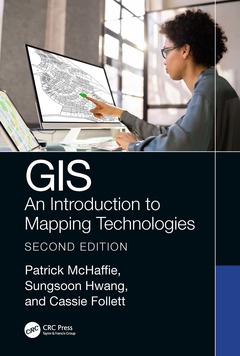GIS (2nd Ed.) An Introduction to Mapping Technologies, Second Edition
Auteurs : McHaffie Patrick, Hwang Sungsoon, Follett Cassie

The second edition of this introductory GIS textbook is thoroughly rewritten and updated to respond to the demand for critical engagement with technologies that address relevant issues across several disciplines preparing students for higher-level work in geotechnologies. Chapters are arranged to (1) build competence in fundamental skills, (2) explore applications of higher-level managerial and analytical functions that are typically called upon in public, nonprofit, and private sector milieu, and (3) propose and detail a template for organizing, executing, and completing a GIS project successfully. This interests all users from beginners to experienced professionals.
Features:
- Uses the latest version of ArcGIS Pro (3.0) to present a fully rewritten and updated text with diverse perspectives.
- Includes many real-world examples with urban planning, environmental, and social justice foci.
- Presents new discussions, examples, and lab materials on open-source GIS projects.
- Includes lab activities and data available for download from Support Materials.
Junior and senior level undergraduate students taking courses in remote sensing and GIS applications, studying in the fields of Geography, Environmental Sciences, Computer Science, Urban Studies, Public Health, and Social Disciplines, as well as researchers and academics in the same fields, will all benefit from the information provided in the updated version of this book.
1. Making Sense of Geotechnology 2. Georeferencing 3. Getting the World into Your GIS 4. Geospatial Analysis: Introduction 5.Thematic Mapping 6. Data Models 7.Web GIS 8. Open-Source GIS 9. Introduction to Remote Sensing and GIS 10. Introduction to Health GIS Applications 11. GIS and Digital Humanities 12. Organizational GIS
Patrick McHaffie: Professor McHaffie joined the faculty at DePaul University in 1996 after academic appointments at West Virginia University, Dartmouth College, and West Georgia College. During the 1980s he served with the Kentucky Geological Survey where he conducted environmental research related to coal mining, directed the National Cartographic Information Center affiliate office, and coordinated the State Topographic Mapping Program. His research interests and publication history include the social history of cartography and GIS, the cartographic labor process, cartographic ethics, the geography of education spending, Appalachian social geography, and the social construction of the global. He currently is completing a study of highway planning in Chicago during the cold war. His work has been supported by grants from the National Science Foundation, History of Cartography Project (University of Wisconsin), and the University Research and Quality of Instruction Councils (DePaul University), and he holds a GIS Professional (GISP) certification.
Sungsoon Hwang: Sungsoon Hwang is an associate professor in the Department of Geography at DePaul University. She earned her BA in Geography Education from Seoul National University. She earned her MS in Geographic Information Systems from the University of Nottingham. She earned her PhD in Geography with a concentration on Urban and Regional Analysis from State University of New York (SUNY) at Buffalo. She has created and taught 20 courses related to GIS. She has published on fuzzy geodemographics, GIS for sustainability education, and uncertain GPS trajectory computing in the disciplines of geography, urban planning, and computer science.
Cassie Follett: Cassie Follett is the GIS Coordinator for the Department of Geography at DePaul University, helping to plan and expand GIS capabilities on-campus and managing the new GIS Lab. Before coming to DePaul she worked for NASA and
Date de parution : 05-2023
17.8x25.4 cm
Thème de GIS :
Mots-clés :
Geospatial, Geoinformatics, Computational social science, Spatial Analysis, Location analysis, Remote Sensing, Digital Cartography, Urban informatics, Environmental Informatics, Health Informatics, Web GIS Application, GIS Professional, ArcGIS Online, Contents Pane, Geospatial Data, Desktop GIS, TRI Facility, Choropleth Map, UTM 16N, Data Model, GIS Program, GIS Dataset, Census Tracts, Layer Properties Window, ESRI Shapefile, GIS Software, Cook County, Open Source GIS, Single Static Map, SPC System, CSV Format, UTM Zone, ArcGIS Server, HIV Diagnosis Rate, Proportional Symbol Map



